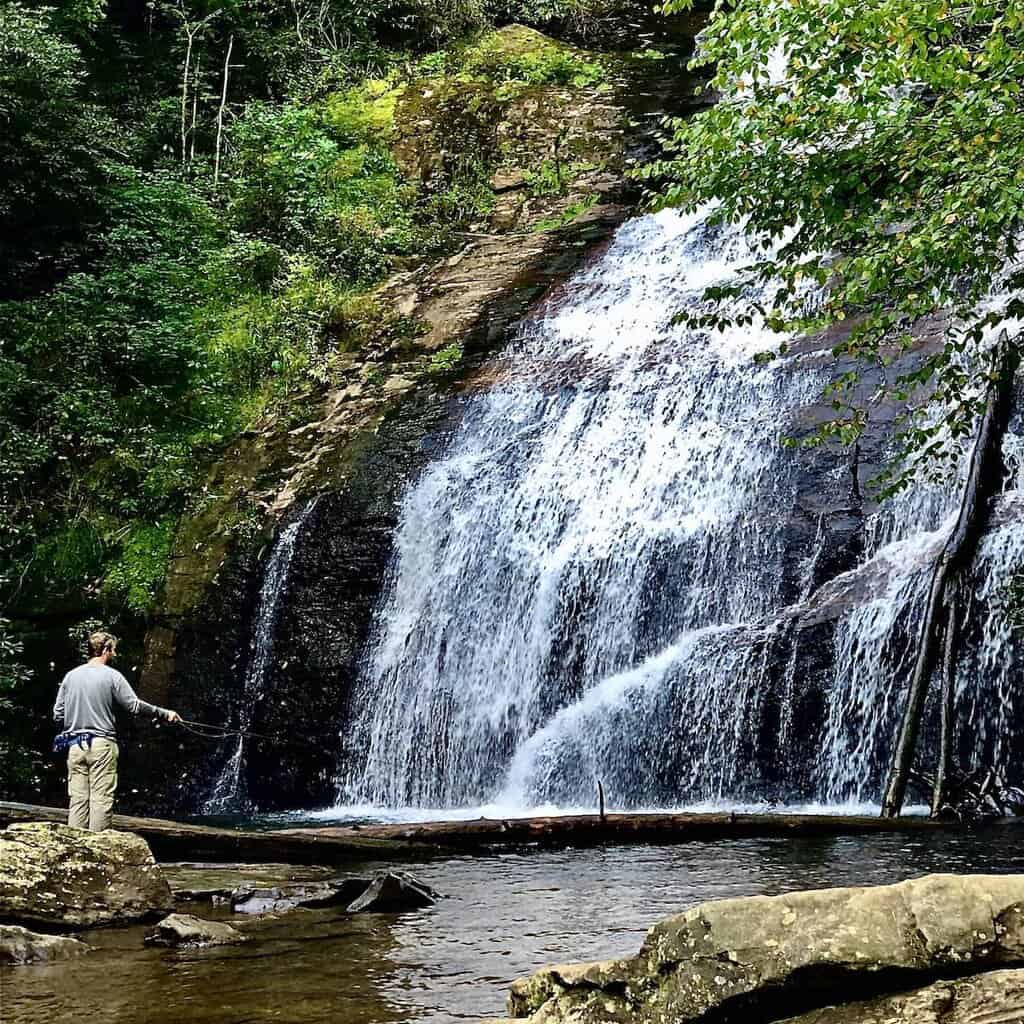From tiny streams with native brook trout to family-friendly lakes heavily stocked with rainbows to brown trout pushing 30 inches, Georgia has incredible trout fishing opportunities for every kind of angler.
Whether it’s wild brook trout, hearty rainbows, or 20-plus-inch browns you’re after, Georgia can be a phenomenal state to trout fish in just about year round.
The state’s park system is incredible, with large areas of preserved wilderness where mountains, forests and pristine streams are protected for future generations to enjoy.
The Georgia Wildlife Resources Division and the U.S. Fish & Wildlife Service’s state and federal hatchery programs stock trout into creeks, rivers and lakes to boost recreation for trout anglers, especially in the cooler mountains of North Georgia.
We enlisted the help of Georgia expert fly fisherman and guide Tad Murdock to assemble a list of some of the state’s most promising trout water and all the information you’ll need to take advantage of this incredible state’s rivers, creeks and lakes.
Best Trout Fishing Creeks
Let’s first look at the creeks that make up quite a lineup of Georgia’s best trout waters.
These locations will have you catching trout in a mix or easily accessible to more remote mountain streams.
Rock Creek
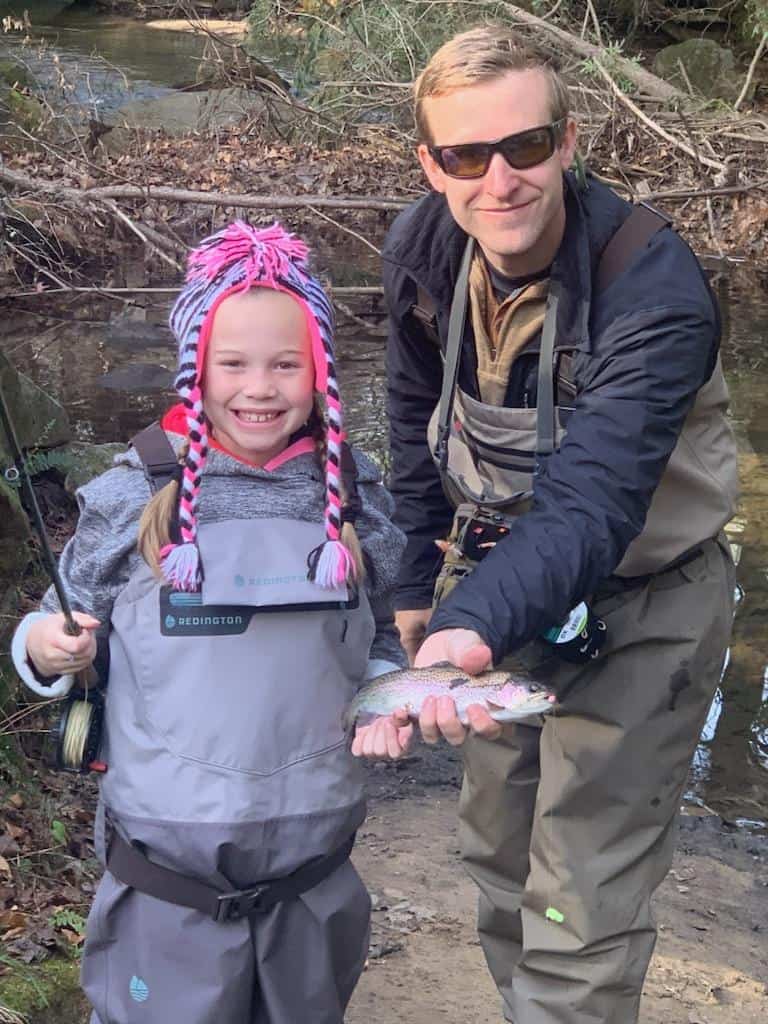
One thing to know about Rock Creek right up top is that it flows right by a hatchery west of Suches.
This largely guarantees that this Toccoa River tributary is getting some freshest trout stocked yearly from the Chattahoochee Forest National Fish Hatchery.
The hatchery raises brown, brook and rainbow trout, although Rock Creek is most heavily stocked with rainbows. There are brown trout mixed in, but they are less common.
Rock Creek Road parallels the stream for the first few miles between Rock Creek Lake and the hatchery, making access very easy. Many anglers pull off the road and fish this stretch.
For larger fish that see less pressure, wade to the section that flows away from the road.
If you search ‘Little Rock Creek Falls Trailhead,’ you’ll find a scenic waterfall off Rock Creek Road.
If you hike west of the falls, you’ll find Rock Creek away from the crowds. Since this stretch requires a some walking, your odds of finding less pressured fish here are greater.
Small spoons, flies that imitate a hellgrammite, and Pautzke Fireballs (a small, red egg imitation) are all popular methods for taking stocked rainbows on this stream.
The relative ease of access on several sections and regular stocking make this a favorite for anglers taking kids or beginners fishing. From where Rock flows into the Toccoa River up to the hatchery, you’ll see good numbers of stocked fish.
The tributaries flowing into Rock Creek are more apt to have wild fish.
Access: The Frank Gross Recreation Area is a campground on Rock Creek Road below the national hatchery, where you can park and bring pets.
Wildcat Creek
Flowing into Lake Burton in Rabun County, Wildcat Creek is another Georgia favorite that gets heavily stocked with rainbow trout every year.
The scenery, stars, and fishing can all be incredible.
One highlight of this creek is the collection of state-maintained campgrounds in the North Georgia mountains. There is no reservation system for camping, it’s done on a first-come, first-served basis.
Wildcat 1 Campground, for example, is located on Wildcat Road in Clarksville and is open to tent campers.
Near where it flows into the lake, Wildcat Creek is more accessible, with Verner-Kastner Lane following the stream until Wildcat Road takes over and runs streamside heading west.
Wildcat Campground #2 is farther west, where the stream begins to veer away from public roads. This might be a better option for those looking to do some hiking in search of trout that don’t see as much angler pressure and will be more cooperative.
The stream has some small, secluded sections that flow through beautiful wooded areas with miniature falls and pools that provide ideal trout-holding water.
Little spoons and small soft plastics (like micro grubs) worked through the pools can be incredibly effective, as can small streamers if you’re fly fishing.
Access: Wildcat Road parallels the stream for about two miles above Lake Burton, and parking roadside is your best option. After Wildcat road veers north and the stream continues west, it will take some hiking to access the westernmost stretches of the creek.
Mountaintown Creek
If you’re looking for a more natural experience, an alluring part about fishing Mountaintown Creek you have a realistic shot at catching wild trout on public water along with an easier opportunity to hook less savvy stocked trout.
Henshaw Branch and Heddy Creek combine in the Chattahoochee National Forest to form Mountaintown Creek, which flows for more than 20 miles to the Coosawattee River.
Mountaintown Creek is part of the upper Coosa River Basin, one of the country’s richest areas in terms of the number of endemic species. More than 30 types of creatures and plants, ranging from trout to snails, call this area home.
One of the keys to this stream maintaining its blue-ribbon status is that it’s heavily forested, which keeps the water temperature cooler. Typically, Mountaintown Creek doesn’t get warmer than 70 degrees, even during the summer.
A plethora of insect life, which expert Tad Murdock stresses isn’t always available in other Georgia streams, keeps these fish rising and feeding throughout the year.
There are healthy populations of reproducing trout both above and below Hills Lake Reservoir east of Rte. 241.
The local Trout Unlimited group has worked hard to place stream structures to help reduce bank erosion and provide structural cover for the brown and rainbow trout, which aren’t native here but have adopted the stream as their own.
On top of that, Georgia Wildlife Resources Division tends to stock trout in the stream twice per month from April to about Labor Day, providing easy targets for trout anglers.
Access: State Route 241 parallels Mountaintown Creek for a stretch between Bear Creek Campground and Gates Chapel Road.
Amicalola Creek
Although it’s called a creek, the Amicalola that flows along the southern edge of the Blue Ridge mountains is more than wide enough at various points to be considered a river.
Amicalola Falls State Park Road runs through the state park on the creek, providing creek access. The Route 53 bridge is a very popular access point.
Also in this location is a bend known as “Devil’s Elbow,” a favorite trout pool north of the Rte. 53 bridge that often holds fish and is easy to access.
The Amicalola is a designated trout water, meaning only single hooks are allowed in the ‘Delayed Harvest’ stretch (which flows from Steele Bridge to the Rte. 53 bridge). All trout must be immediately released from the opener in November up until mid-May, when the rules ease up. Always check for updates.
Historically, browns were stocked on the Amicalola, but at this writing, hatchery-produced rainbows are the main target here.
Attractor patterns can be especially productive as the water warms in the early spring.
Access: The Edge of the World Trail starts off Highway 53 in Dawsonville and follows along Amicalola Creek, allowing hiking anglers to get away from heavily fished sections.
Cooper Creek
Cooper Creek sits near the top of the list of most popular trout fishing waters in North Georgia.
Here’s a good reason for that: Cooper is annually stocked with as many as 40,000 rainbow trout. There are brown trout in Cooper, but rainbows are much more common.
The creek begins in earnest near the Lake Winfield Scott Dam and flows into the Toccoa River north of Suches.
One attraction at this creek are public recreational areas along the stream’s edge.
The U.S. Forest Service maintains Cooper Creek USFS Campground off Rte. 236. You’ll find fishing access just east of the campground.
The Cooper Creek fishing bridge off Forest Service Road 33a is another prime access point.
Corn and crickets will work wonders for the bait-fishing crowd, and hellgrammite patterns are a popular choice for anglers waving the long rod.
Primitive camping areas exist along the creek that anglers can reserve online. For example, the Cooper Creek Campground has sites with drinking water, hiking trails, public restrooms, tent pads, tables and campfire rings.
Access: Mulky Gap Road follows along the banks of the creek and leads to the Cooper Creek Campground, about 13 miles southwest of Blairsville.
Nimblewill Creek
The Nimblewill is stocked weekly in the spring and early summer up until sometime around the Fourth of July, and then occasionally from mid-summer to early fall. So the odds are pretty good that no matter when you go, you’ll find some stocked trout.
Nimblewill Creek tends to be a shallower stream with fewer deep holes when compared to nearby streams, meaning the fish you’re targeting are more likely to be visible.
Nimblewill Gap Road runs along the creek near its headwaters and also for a stretch farther downstream.
The creek eventually dumps into the Etowah River, but lower stretches are more difficult to access because they flow through private land.
The Nimblewill is a popular dry fly stream, with attractor patterns working well for both stocked and wild rainbows.
Access: Nimblewill Gap Road runs creekside and is your best bet for finding a promising pull-off near productive water.
Smith Creek
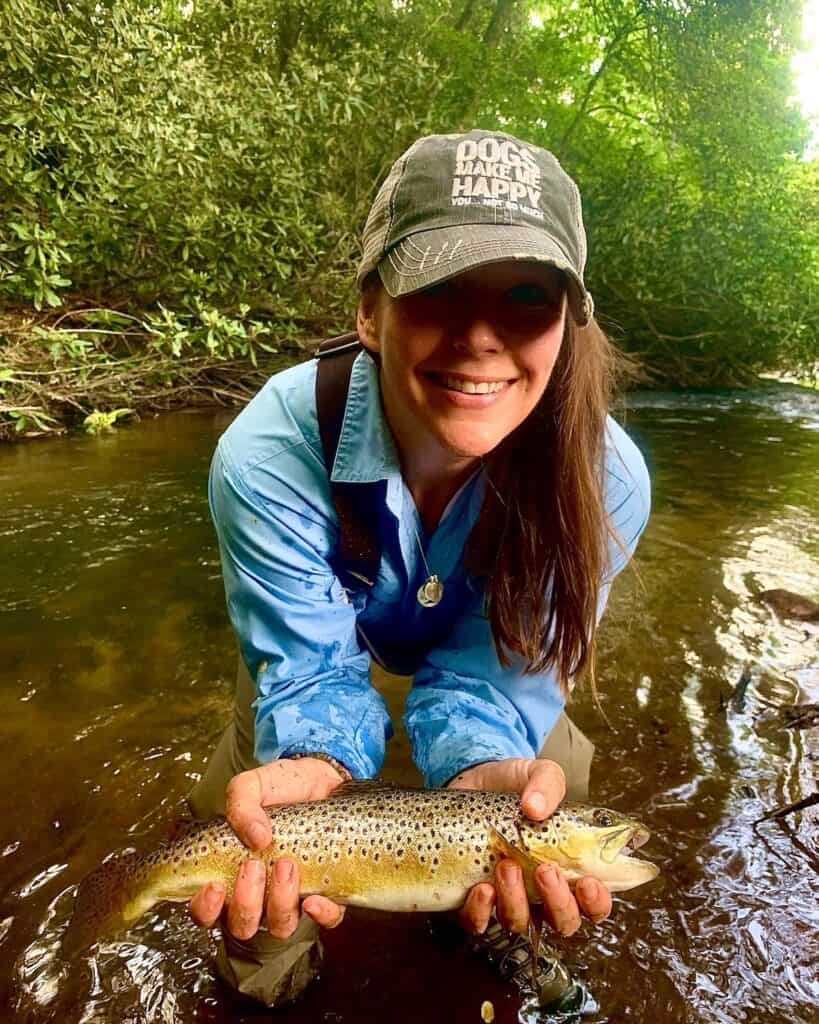
Smith Creek was one of the first streams in the state designated (in the late 90s) as a Delayed Harvest stream. Between November 1 and May 14, anglers can only use artificial lures with a single hook and release their catches.
So it stands to reason that the stream that received this designation first has had the most time to reap the greatest benefit.
The element that makes the Smith endearing decades later is that it is still among the smallest streams in the state to have received this designation.
If you want to target a body of water with good numbers of healthy fish even well after opening day, and you want to do it wading a small creek, Smith Creek is perhaps one of your better options.
Another promising element about the Smith is that it features brown, rainbow and brook trout.
The West Fork and East Fork of Smith Creek combine near York Ridge to form the main stem, which flows into the Chattahoochee.
Attractor patterns like a Royal Wulff are a good option, but keep in mind that the stream is relatively small, meaning smaller rods and roll casts might be necessary.
Access: Anna Ruby Falls Road follows Smith Creek and is the only public access in the upper section. As you get closer to where the Smith joins the Chattahoochee, Unicoi Bottoms Road downstream of Unicoi Lake follows the stream for a stretch in the Unicoi State Park & Lodge.
Best Trout Fishing Rivers
Georgia’s best trout rivers are a bit larger than the creeks … but that also can mean that the trout in them also can run a bit larger.
Chattahoochee River
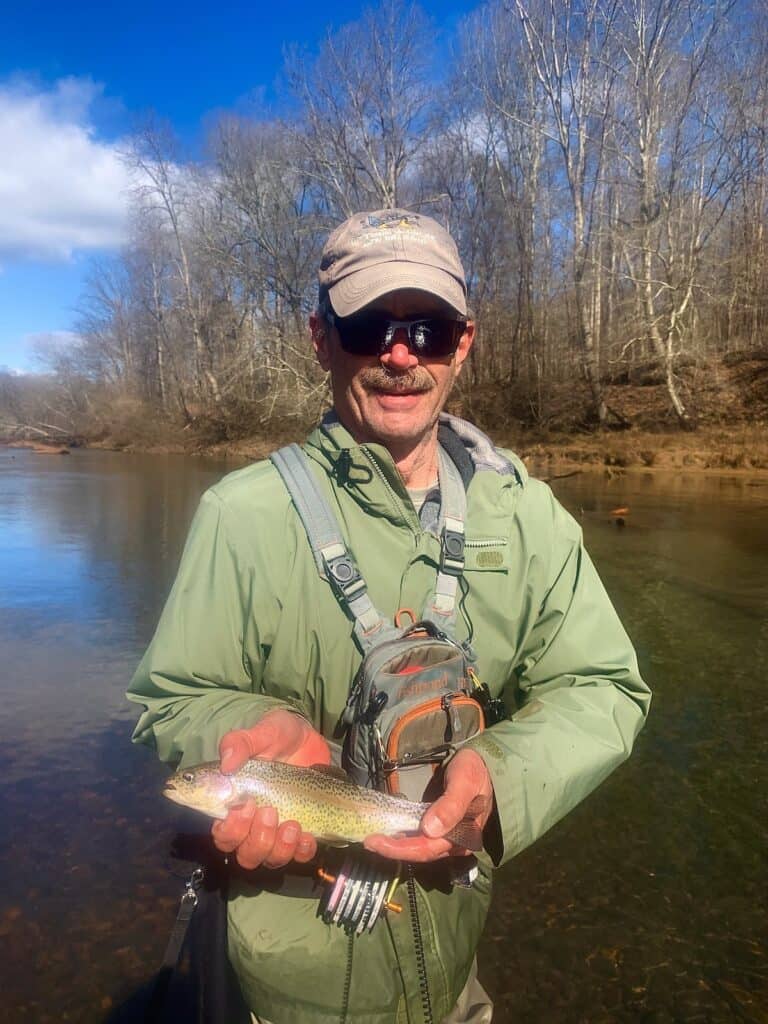
The Chattahoochee is a river in Georgia that has been carefully managed to produce large trout.
Be sure to study the regulations. Certain sections are designated as for artificial lures only or delayed-harvest seasons. Some stretches require anglers to use single hooks.
The ‘Hooch,’ as long-time Georgia guide Tad Murdock calls it, is a designated trout stream from Buford Dam to the mouth of Peachtree Creek. Anyone fishing that reach needs to purchase a designated trout stamp in addition to the Georgia freshwater fishing license.
Murdock said the Chattahoochee is typically wadeable, except when heavy rains and runoff turn it high or muddy.
An enticing aspect of the Hooch is that the brown trout in this river are all wild.
Murdock said that the upper stretches of the Chattahoochee can feature a consistent midge bite year-round. He added that those parts of the river fish more like a small stream than a river.
Need more motivation? Murdock estimates that he’s seen five fish on the Hooch that he believes were all of 30 inches. Plus, the state record brown trout, a 20-pound, 14-ounce behemoth, was caught in the recent past.
Access: Settles Bridge on Settles Bridge Road in the Chattahoochee River National Recreation Area is one of the river’s better spots for wading. However, knowing the timing of dam releases is always a good idea.
Toccoa River
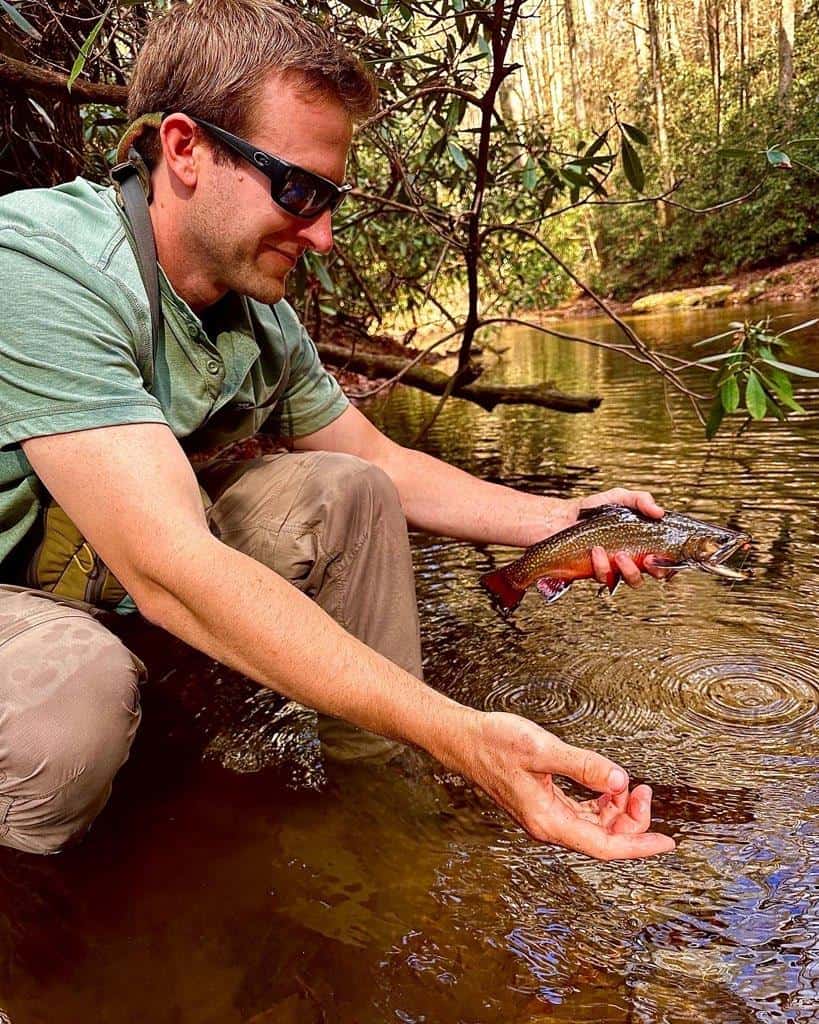
The Toccoa is formed where Cochran Creek and Mauldin Creek come together in the Blue Ridge Wildlife Management Area. It flows northwest and is joined by smaller creeks and streams until it reaches Blue Ridge Lake.
While wild brook trout are more common in the headwaters, brown and rainbow trout become more popular as the river descends and slows. There are both stocked and wild fish in this stretch.
This stretch of the river is heavily forested, scenic, and because it is catch-and-release only from November to mid-May, the fishing can be incredible.
Rainbows pushing 20 inches will attack streamers and small spoons.
Late February and early March can produce a great black caddis hatch.
The brown trout can push 20 inches as well, and you’ll find them pushing into smaller creeks that flow into the Toccoa in October and November, which can be a great time to target them in shallower water.
Pheasant-tail nymphs or hare’s ears can be effective for the stocked rainbows, while big, articulated streamers are popular for the biggest brown trout.
If it’s brook trout you’re after, start your search in the upper watershed above 2,000 feet in elevation, where you’ll have the best luck.
Mepps, small stickbaits and spoons will work on sections where spin fishing is allowed.
Access: The Toccoa River Sandy Bottoms Recreation Area on Old Dial Road provides riverfront parking and access.
Conasauga River
The Conasauga takes an interesting path, beginning where Cowpen Creek, Poplar Springs Branch, Chestnut Creek and Potatopatch creek all flow into it on Cohutta Mountain near Ellijay.
The river flows north, into Tennessee, before turning and heading back south into Georgia, where it flows into the Coosawattee River. The river flows for about 95 miles along its entire stretch.
One highlight of the Conasauga is ease of access.
Norton Bridge Road crosses the river just north of the Conasauga River Wildlife Management area.
Just east of the Hickory Creek Trailhead off Route 630, you’ll see the confluence of Rough Creek and the Conasauga.
As the river slows and warms after this point, it has thriving populations of bass, catfish, carp, freshwater drum and suckers. So concentrate your efforts for trout above Rough Creek, for the most part.
It can be incredible trout water, with populations of rainbow, brown and brook trout, including some native brook trout in the river’s headwaters reaches. Most brook trout will be in the cooler streams above 2,000 feet.
If you’d rather catch larger trout than small, beautiful ones, keep in mind there are brown trout pushing 20 inches caught in the Conasauga every year.
Remember that these browns are wild fish and approach the river with as much stealth as possible, as they’ll be warier than their stocked counterparts.
Rooster Tails and Phoebe Wobblers are good bets for spinning anglers.
If you’re fly fishing, know that insect hatches aren’t common here. That makes attractor patterns a top option for dry fly purists, and drifting nymphs through the pools is another top tactic for the fly set.
Access: There is a parking area for the Hickory Creek Trailhead near Mill Creek Road (Rte. 630) and W. Cow Pen Road intersection. Farther north, Old Highway 2 crosses the Conasauga in Murray County.
Tallulah River
One key to finding Georgia trout is looking for the higher elevations that keep mountain streams cooler year-round.
The U.S. Forest Service’s Tallulah River Campground off Tallulah River Road in Clayton sits at more than 2,000 feet above sea level.
The campground is open year-round, including a few RV spots plus tent camping and easy access to hiking trails and the river.
The best part for anglers is that the Tallulah is regularly stocked with rainbow trout. Your chances of finding eagerly cooperative fish are high here.
The Tallulah is a great option if you’re looking for a wilderness experience that is still family-friendly and low on the difficulty scale. It is also a beautiful body of water with heavily wooded areas and small waterfalls throughout.
A Parachute Adams can be an effective fly in the spring, and large attractor patterns and even grasshopper imitations can work well for rainbows pushing 15 inches in April and May. Elk Hair Caddis are another popular choice for the fly anglers.
Rooster Tails rarely fail for the spinning crowd on the Tallulah.
Access: Tallulah River Road runs along much of the river and turns into Tate City Road and continues to parallel it. Campgrounds like Sandy Bottoms Campground, Tate Branch Campground, and the Tallulah River Campground are all along this road for anglers looking to make a weekend out of the trip.
Chattooga River
One endearing element about the Chattooga is depending on which stretch you fish, you’ve got chances at all three species of Georgia’s wild trout (brown, brook and rainbow).
You also will be fishing a river that sits at the border of three states (Georgia, South Carolina and North Carolina).
If you find yourself fishing in the Ellicott Rock Wilderness where Bad Creek flows into the Chattooga, you will have the chance at three species of trout at the intersection of the three states.
Trout Unlimited has called the Chattooga one of the 100 best trout streams in the country, and it’s one of the top 10 longest free-flowing rivers in the southeastern United States at more than 52 miles.
Although most brown trout are between 10 and 15 inches, there are browns up to 25 inches to be caught by persistent anglers.
Blue-winged olives and Light Cahills are good options before the water warms in the summer. Then, pheasant tail nymphs can be a good summer bet.
In fishing the Chattooga, you have the potential for truly trophy fish. The river gave up a 4-pound, 10-ounce brook trout that broke a South Carolina record, and there’s always the potential to land a 20-plus-inch brown trout.
Given that, plus good chances at both well-stocked fish in some stretches and warier, wild fish in others, it has to make our list.
Also, if you ever feel like you’re on the scene of “Deliverance,” it’s because you are: Parts of the movie were filmed on the Chattooga.
Access: The Chattooga River Trail begins off Burrells Ford Road, which crosses the river on the Georgia/South Carolina state line. You can follow the trail all the way to where all three states meet, and it’s roughly 11 miles in total length.
Georgia’s Top Trout Fishing Lakes
If your idea of trout fishing is less about stealthfully wading a small mountain creek and more about plunking some PowerBait or trolling lures for limits of cooperative trout, Georgia’s lakes have you covered.
The following handful of lakes are regularly stocked with trout and are great places to spend a day of casual trout fishing with good odds of catching dinner.
Lake Winfield Scott
Winfield Scott Lake near Suches is a great option for a family excursion because state-maintained pavilions, benches and docks mean you’ve got access to regularly stocked water with a very low level of difficulty.
Lake Winfield Scott Road, on the lake’s east side, features a covered wooden picnic area right on the lake.
PowerBait is a great option here, as stocked rainbows love this stuff that closely resembles their hatchery diet.
The lake is stocked twice a month from April to early July and is popular with local anglers.
The fact that the lake itself is only 18 acres in size means that the stocked fish don’t have a ton of water to hide from anglers.
Another bonus is that you can rent the picnic shelters for a small fee or secure a campsite for a night.
Access: The Lake Winfield Scott Recreation Area is off Lake Winfield Scott Road, on the lake’s eastern shore.
Lake Trahlyta
This lake in Vogel State Park, south of Blairsville, is stocked twice a month with trout in the spring and early summer, which is one very good reason it’s a prime destination for anglers looking for still-water trout fishing.
It’s a great option, too, because at 2,500 feet above sea level, at the foot of Blood Mountain, Lake Trahlyta stays cooler than lakes in lower elevations. That provides more comfortable water temperatures for trout later into the spring and earlier in the fall.
Wolf Creek flows into one end of the lake and out the other and the moving water can be a prime place to target trout from shore, either with bait or small lures.
Note that motorized boats are not allowed on Trahlyta.
The 22-acre lake is small enough that it can be explored in a day, and because it’s on state park land, you’ve got amenities like picnic tables, a sand beach, a pavilion, R.V. hookups, and tent sites.
Vogel State Park is Georgia’s second-oldest state park and is located in the Chattahoochee National Forest. With a general store, a playground for the kids, and even a seasonal museum, this is an ideal spot for a family fishing trip.
Access: Vogel State Park entrance is off Route 129, near the southeast corner of the lake.
Black Rock Lake
This 17-acre lake in Black Rock Mountain State Park gets heavily stocked with rainbow trout during the spring and early summer.
WIth a pier, bridge, and a maintained trail that circles the entire lake, Black Rock is another good option for families with little anglers looking for ease of access.
There are steep drop-offs right near the public access points, and PowerBait or small spinners cast out near the steeper banks are good options for any anglers.
Some brown trout are stocked in Black Rock periodically, but the vast majority of the trout you’ll encounter are rainbows. You may also catch bass here.
Located near Mountain City, this is another body of water where an elevation of more than 2,000 feet keeps the lake cooler than it might be in a valley, extending the trout season.
Access: Taylor’s Chapel Road runs along the northeast corner of the lake.
Nancy Town Lake
One highlight of fishing Nancytown, south of Mt. Airy, is that while you might go in pursuit of trout, you’ve got the chance for bass and sunfish in the same lake.
This variety makes it another great option for fishing families that aren’t opposed to a multi-species affair.
Also spelled Nancytown, this is a lake that is primarily stocked with rainbows, so your best chance at bending the rod multiple times is heading out in the early spring before waters warm up enough to make those fish sluggish.
Although the bass and sunfish are likely to be cooperative even after the trout fishing slows for summer.
Access: Lake Russell Road runs along the northwest side of the lake, and a day-use area is on the lake’s south end.
Dockery Lake
Last but not least, Dockery Lake is a very small lake north of Dahlonega, known for having regularly stocked and cooperative trout during the spring and early summer.
The lake is on a tributary of Waters Creek, one of the state’s first designated trophy trout waters. The moving water near the inlet may attract Dockery Lake’s trout.
Dockery is in the Cedar Ridge Range within Chattahoochee National Forest and offers a small, seasonal campground and day-use area in a beautifully forested setting.
Access: Dockery Lake Road in Dahlonega runs along the southeast side of the lake.
Summary
Whether you’re looking for 20-plus-inch broodstock brown trout or native brook trout high in the Appalachian mountains, North Georgia can undoubtedly make a claim as one of the best trout fishing destinations while the rest of the state is better known for bass fishing.
In Georgia’s mountains, you can enjoy stocked rainbows on ponds and streams in the spring or target shallow-water spawning brown trout in the late fall.
We hope this guide points you in the direction of many memorable moments on the water.
Acknowledgment
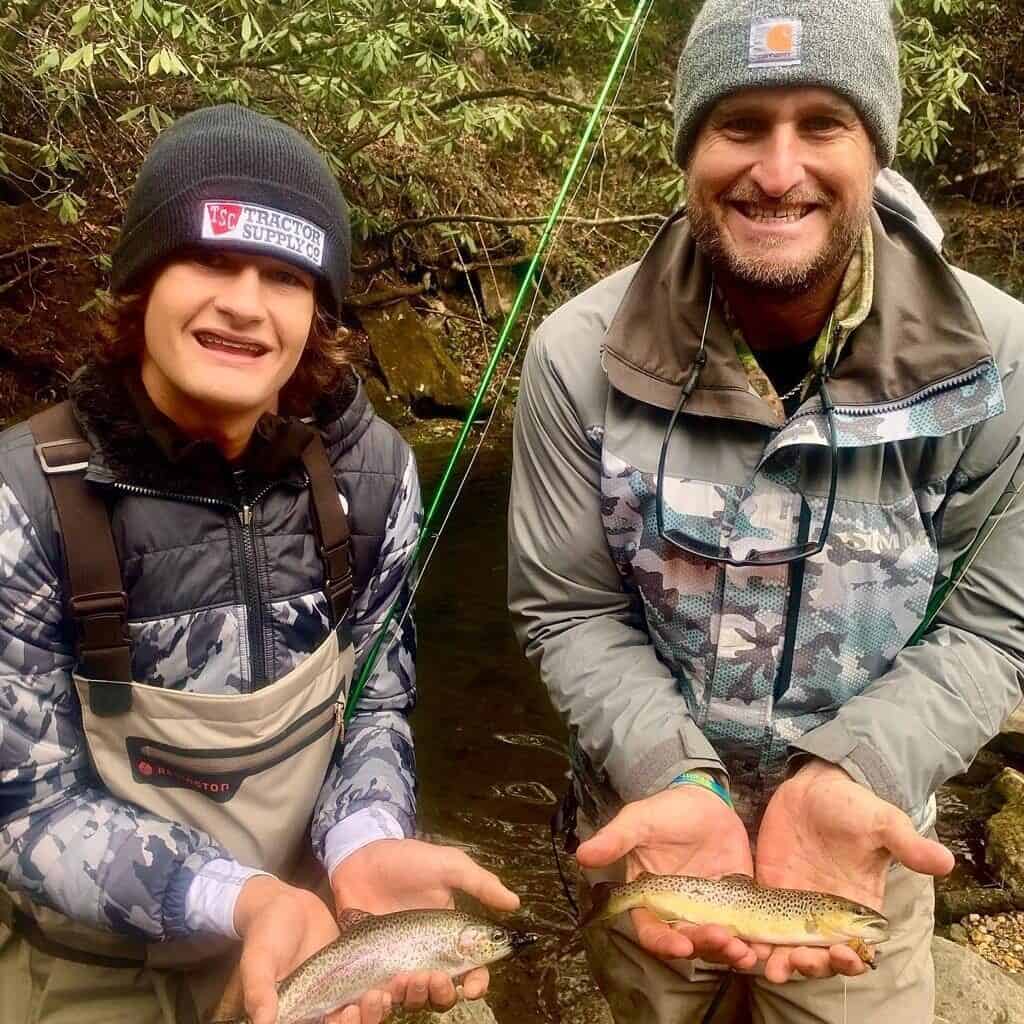
Thanks to Tad Murdock of Georgia Wild Trout guide service for sharing his local expertise, especially when it comes to fly fishing on North Georgia’s best trout streams.

